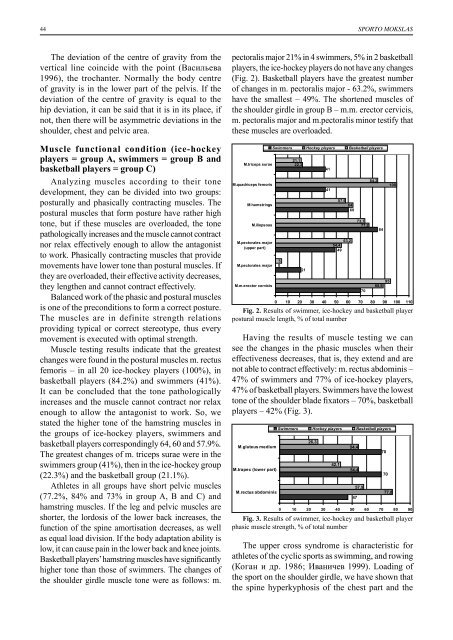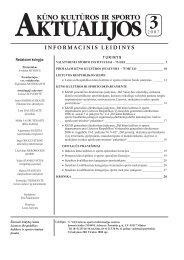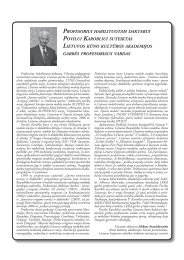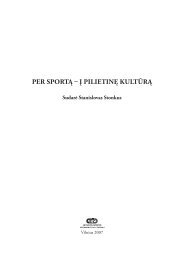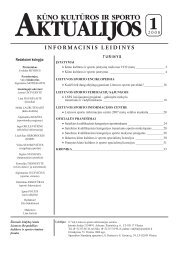Nr. 1 - Lietuvos sporto informacijos centras
Nr. 1 - Lietuvos sporto informacijos centras
Nr. 1 - Lietuvos sporto informacijos centras
You also want an ePaper? Increase the reach of your titles
YUMPU automatically turns print PDFs into web optimized ePapers that Google loves.
44<br />
SPORTO MOKSLAS<br />
The deviation of the centre of gravity from the<br />
vertical line coincide with the point (Васильева<br />
1996), the trochanter. Normally the body centre<br />
of gravity is in the lower part of the pelvis. If the<br />
deviation of the centre of gravity is equal to the<br />
hip deviation, it can be said that it is in its place, if<br />
not, then there will be asymmetric deviations in the<br />
shoulder, chest and pelvic area.<br />
Muscle functional condition (ice-hockey<br />
players = group A, swimmers = group B and<br />
basketball players = group C)<br />
Analyzing muscles according to their tone<br />
development, they can be divided into two groups:<br />
posturally and phasically contracting muscles. The<br />
postural muscles that form posture have rather high<br />
tone, but if these muscles are overloaded, the tone<br />
pathologically increases and the muscle cannot contract<br />
nor relax effectively enough to allow the antagonist<br />
to work. Phasically contracting muscles that provide<br />
movements have lower tone than postural muscles. If<br />
they are overloaded, their effective activity decreases,<br />
they lengthen and cannot contract effectively.<br />
Balanced work of the phasic and postural muscles<br />
is one of the preconditions to form a correct posture.<br />
The muscles are in definite strength relations<br />
providing typical or correct stereotype, thus every<br />
movement is executed with optimal strength.<br />
Muscle testing results indicate that the greatest<br />
changes were found in the postural muscles m. rectus<br />
femoris – in all 20 ice-hockey players (100%), in<br />
basketball players (84.2%) and swimmers (41%).<br />
It can be concluded that the tone pathologically<br />
increases and the muscle cannot contract nor relax<br />
enough to allow the antagonist to work. So, we<br />
stated the higher tone of the hamstring muscles in<br />
the groups of ice-hockey players, swimmers and<br />
basketball players correspondingly 64, 60 and 57.9%.<br />
The greatest changes of m. triceps surae were in the<br />
swimmers group (41%), then in the ice-hockey group<br />
(22.3%) and the basketball group (21.1%).<br />
Athletes in all groups have short pelvic muscles<br />
(77.2%, 84% and 73% in group A, B and C) and<br />
hamstring muscles. If the leg and pelvic muscles are<br />
shorter, the lordosis of the lower back increases, the<br />
function of the spine amortisation decreases, as well<br />
as equal load division. If the body adaptation ability is<br />
low, it can cause pain in the lower back and knee joints.<br />
Basketball players’ hamstring muscles have significantly<br />
higher tone than those of swimmers. The changes of<br />
the shoulder girdle muscle tone were as follows: m.<br />
pectoralis major 21% in 4 swimmers, 5% in 2 basketball<br />
players, the ice-hockey players do not have any changes<br />
(Fig. 2). Basketball players have the greatest number<br />
of changes in m. pectoralis major - 63.2%, swimmers<br />
have the smallest – 49%. The shortened muscles of<br />
the shoulder girdle in group B – m.m. erector cervicis,<br />
m. pectoralis major and m.pectoralis minor testify that<br />
these muscles are overloaded.<br />
M.triceps surae<br />
M.quadriceps femoris<br />
M.hamstrings<br />
M.iliopsoas<br />
M.pectorales major<br />
(upper part)<br />
M.pectorales major<br />
M.m.erector cervicis<br />
Swimmers Hockey players Basketball players<br />
5<br />
0<br />
21,1<br />
22,3<br />
21<br />
41<br />
41<br />
57,9<br />
64<br />
60<br />
63,2<br />
54,4<br />
49<br />
73,7<br />
77,2<br />
70<br />
84,2<br />
84<br />
95<br />
88,9<br />
0 10 20 30 40 50 60 70 80 90 100 110<br />
Fig. 2. Results of swimmer, ice-hockey and basketball player<br />
postural muscle length, % of total number<br />
Having the results of muscle testing we can<br />
see the changes in the phasic muscles when their<br />
effectiveness decreases, that is, they extend and are<br />
not able to contract effectively: m. rectus abdominis –<br />
47% of swimmers and 77% of ice-hockey players,<br />
47% of basketball players. Swimmers have the lowest<br />
tone of the shoulder blade fixators – 70%, basketball<br />
players – 42% (Fig. 3).<br />
M.gluteus medium<br />
M.trapec (lower part)<br />
M.rectus abdominis<br />
Swimmers Hockey players Basketball players<br />
26,3<br />
42,1<br />
54,4<br />
54,4<br />
47<br />
57,9<br />
70<br />
70<br />
77,8<br />
0 10 20 30 40 50 60 70 80 90<br />
Fig. 3. Results of swimmer, ice-hockey and basketball player<br />
phasic muscle strength, % of total number<br />
The upper cross syndrome is characteristic for<br />
athletes of the cyclic sports as swimming, and rowing<br />
(Коган и др. 1986; Иваничев 1999). Loading of<br />
the sport on the shoulder girdle, we have shown that<br />
the spine hyperkyphosis of the chest part and the<br />
100


